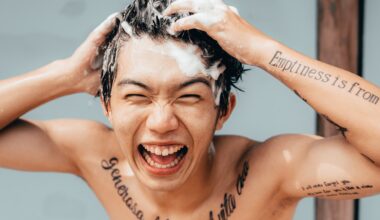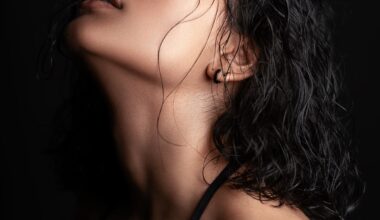Introduction
Hair care is both an art and a science, a delicate balance of understanding one’s unique hair type and the myriad of products available. Among these, hair oil has historically stood out as a tried-and-true ally. Its purpose isn’t merely cosmetic; it provides necessary nourishment, protects against damage, and can transform one’s hair from lackluster to luminous. However, a slight misstep in the timing and technique can turn this remedy into a greasy mess.
Many people, despite their best intentions, find themselves lost when it comes to the ‘how’ and ‘when’ of applying hair oil. Is it best used on wet or dry hair? Morning or night? The answer to these, as I’ve discovered over two decades in hairstyling, can make all the difference. Let’s unravel the secrets together.
The Role of Timing in Hair Oil Application
Why Timing Matters
Time is more than just a tick on the clock when it comes to hair care. With hair oil, timing can significantly amplify or reduce its benefits. Picture this: applying hair oil to damp hair versus extremely dry hair. One method allows the oil to trap the moisture and enhance hair hydration, while the other might just sit atop and give a greasy appearance without deeply penetrating. It’s the subtle art of timing that can transform the mundane task of oiling your hair into a potent hair treatment.
Best Times to Apply Hair Oil
While there’s no one-size-fits-all answer, certain times have been found to be more effective for most:
- Morning Application: For those leading a busy life, applying hair oil in the morning can be ideal. It offers protection against environmental stressors like dust and pollution. A light application ensures you step out with a shine, not a slick.
- Nighttime Ritual: If deep nourishment is the goal, nighttime is the time. Applying oil at night and leaving it on ensures that the scalp and hair shaft absorb the nutrients without the interference of daily activities. Washing it off the next morning leaves the hair refreshed and revitalized.
- Post-Shower: This might come as a surprise to many, but applying a few drops of oil on damp hair post-shower can lock in moisture, making hair soft and manageable. Remember, it’s about using just enough to trap the moisture, not drench the hair.
Seasonal Adjustments
Every season brings its own hair challenges:
- Summers: High humidity can make hair frizz out. A light oil application can act as a barrier, keeping the hair shaft smooth.
- Winters: The cold, dry air can rob hair of its natural moisture. A thicker, richer oil application, especially at night, can prevent hair from becoming brittle.
- Monsoons: With the dampness around, you’d think hair would stay hydrated. On the contrary, the fluctuating humidity can wreak havoc. A balanced approach, perhaps a mid-day touch-up, can be beneficial.
Pro Techniques for Perfect Hair Oil Application
Choosing the Right Oil
Each hair type has its own unique set of needs, and not every oil caters to these. Over the years, I’ve seen countless individuals using the trendiest oils without seeing any noticeable results, only to discover that it wasn’t the right fit for their hair.
- Fine Hair: Lightweight oils like almond or argan can give fine hair the nourishment it needs without weighing it down.
- Thick, Coarse Hair: Richer oils like coconut or castor provide the deep moisturization that dense hair often requires.
- Curly Hair: Jojoba or olive oil, known for their hydrating properties, can keep curly hair defined and frizz-free.
Quantity Matters
One of the most common mistakes made is using excessive oil. Here’s a simple guideline:
- Short Hair: A coin-sized amount is adequate.
- Medium-Length Hair: Double the amount used for short hair.
- Long Hair: Depending on the thickness, anywhere between a large coin to a small lime-sized quantity will suffice.
Application Process
The beauty lies in the details:
- Begin at the Roots: Always start by applying oil to the scalp, using your fingertips. This stimulates blood flow, promoting hair growth.
- Work Downwards: Move from the scalp to the tips, ensuring even distribution. This prevents the tips, often the driest part, from missing out on the nourishment.
- Avoid the Scalp: If you have an oily scalp, avoid applying oil directly to it. Instead, start a couple of inches away, focusing on the lengths and ends.
Massaging Techniques
A good massage can amplify the benefits of the oil:
- Circular Motions: Using the pads of your fingers, make small circular motions. This not only ensures the oil penetrates deeper but also boosts circulation.
- Press and Release: For areas with thicker hair, use a press and release motion to ensure the oil reaches the scalp.
- Palm Massage: For the lengths, take some oil on your palms, rub them together to warm it up, and then glide down the hair. This ensures an even application.
Post Application Tips
Now that the oil is applied:
- Tie It Up: If you’re keeping the oil on for an extended period or overnight, tie your hair in a loose bun or braid to prevent it from tangling.
- Use a Towel: Especially if applying a generous amount of oil, wrapping your hair in a warm towel can enhance absorption. The warmth opens up the hair cuticles, allowing deeper penetration.
- Wash Thoroughly: When it’s time to wash, ensure that all the oil is removed to prevent any residue. Sometimes, a double cleanse might be necessary.
The Transformative Benefits of Mastering Hair Oil Application
A Strong Foundation: The Scalp
Just as plants thrive in well-nourished soil, hair grows best from a healthy scalp. Regular and correct oil application:
- Boosts Circulation: The act of massaging during application stimulates blood flow, bringing more oxygen and nutrients to the hair follicles. This can invigorate dormant hair follicles and promote healthier growth.
- Balances Oil Production: Overwashing or using harsh products can strip the scalp of its natural oils, leading it to produce more oil in compensation. Regular oiling can help maintain a balance, preventing the scalp from becoming too oily or too dry.
Revitalized Hair Shafts
The lengths of our hair often suffer the brunt of environmental aggressors, heating tools, and chemical treatments. Here’s how proper oiling helps:
- Locks in Moisture: As discussed earlier, applying oil to damp hair can trap moisture, keeping the hair hydrated for longer. This can prevent dryness and the associated breakage.
- Protects Against Damage: The outermost layer of our hair, the cuticle, can get lifted due to damage, making hair look frizzy and dull. Oils can smooth down the cuticle, providing a protective shield against physical and environmental damage.
Shine, Softness, and Beyond
The immediate effects of oiling can be seen in the form of shinier, softer hair. But there’s more:
- Reduced Split Ends: The tips of our hair are the oldest and often the most damaged part. Regular oiling can seal split ends and prevent them from worsening.
- Enhanced Texture: For those with wavy or curly hair, oil can define the natural texture, reducing frizz and making curls and waves pop.
- Natural Fragrance: Many oils have their own unique fragrances. A well-oiled head of hair can leave a subtle, pleasant scent in its wake.
A Calming Ritual
Beyond the physical benefits, the act of oiling one’s hair can be therapeutic:
- Stress Relief: The massage, combined with the fragrance of some oils, can be immensely relaxing, offering a brief respite from the hustle and bustle of daily life.
- Bonding Time: In many cultures, oiling someone else’s hair is a bonding ritual between parents and children or between friends. It’s a time of care, love, and connection.
Conclusion
Hair oil application might seem like a simple act, but as we’ve journeyed through its intricacies, it’s clear that mastering this art can lead to transformative results. The impact of this age-old ritual isn’t just superficial; it deeply nourishes and revives, laying a foundation for hair that not only looks radiant but feels resilient.
A combination of correct timing, technique, and understanding the nuances of one’s hair can unlock benefits that go beyond aesthetics. It’s not just about the sheen and softness; it’s about fostering a stronger, healthier foundation for growth. And perhaps, in these moments of self-care, one can find solace, reflection, and rejuvenation.
In the ever-evolving world of hair care, with trends that come and go, the timelessness of hair oil application stands unwavering. Its potency is a testament to the generations of women and men who have sworn by it. And as someone with over 20 years in hair styling, I can assert that embracing this art is one of the best gifts you can give to your tresses.
Whether you’re new to this or looking to refine your technique, remember: it’s more than just oil and hair. It’s a celebration of oneself, a ritual of love, and a journey towards hair that truly embodies vitality.






